
“Mystery creates wonder and wonder is the basis of man’s desire to understand.” – Neil Armstrong
* * *
What is a cozy mystery? And how has this popular sub-genre evolved over time? Since fellow TKZ contributor Dale Ivan Smith and I both write cozies, we thought it would be fun to co-write a post on the subject.
WHAT MAKES A MYSTERY “COZY?”
These are the basic “rules” as I understand them:
- No explicit violence.
- No explicit sexual content.
- Usually, no profanity. But if there is any, it’s mild.
Although there are many variations, a cozy mystery often involves a murder that has taken place “off stage” before the story begins. The mystery is usually presented as a puzzle where the reader tries to figure out the solution along with the protagonist.
This quote from an article on novelsuspects.com sums it up nicely:
“Overall, cozy mysteries are the perfect mix of smart, thoughtful stories that challenge you to think as you read while also being a relaxing escape from everyday life.“
HISTORY
Mysteries have been around for a long time. The first mystery novel is usually identified as The Woman in White by Wilkie Collins, published in 1859. But Agatha Christie changed the landscape in 20th century.
According to an article on the website of the Mansfield/Richland County Public Library in Mansfield, Ohio:
“Agatha Christie is usually credited with being the (unintentional) mother of the cozy mystery genre with her Hercule Poirot and Miss Marple series. The term “cozy” was first coined in the late 20th century when various writers produced work in an attempt to re-create the Golden Age of Detective Fiction.”
* * *
Since its inception, the cozy mystery genre has evolved, and a few new trends have grown up around it. For example, many of today’s cozies have paranormal elements you wouldn’t have found in the mid-20th century. It also isn’t unusual for stories to center around food or pets.
Book covers have also morphed to reflect a more playful approach, and many titles have become something of a pun contest. To the best of my knowledge, the images shown below were the first edition covers. Consider how things have changed from the 20th century …
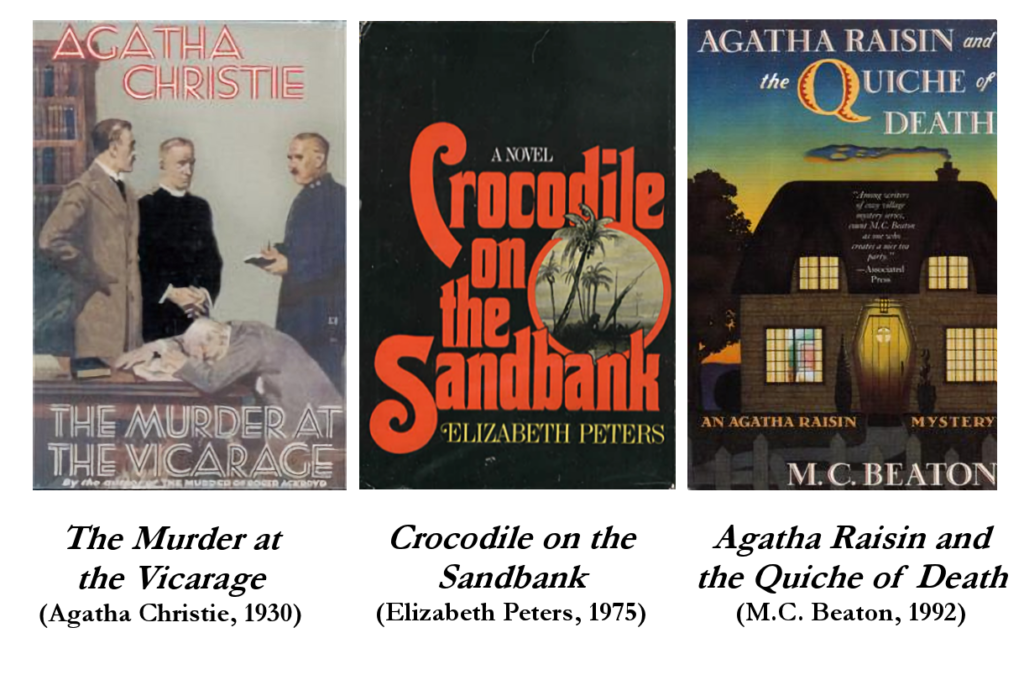
… to the 21st century:

* * *
Over to Dale to give us background on the cozy narrative:
We’re so often advised to begin with action. However, cozies tend to call for the grounding of the reader in the character’s background and setting right at the start, to help give that cozy feel and connect the reader with our heroine. The heroine is often introduced in a summary of who-the-character is fashion, rather than an in-media-res opening that other mysteries might.
Often we also learn how she arrived at this point in her life—perhaps she just went through a divorce, or lost a job, and moved to the small community, possibly inheriting a business and meeting a character who will be significant in their life. If they are already established, like in Jenn McKinlay’s Books Can Be Deceiving, the first of her Library Lovers series which opens with the Thursday “Crafternoon” group meeting at the library.
The murder can occur in the opening, but often occurs later, and serves as the gateway to Act II. While the opening of a cozy often establishes the world before the murder, the discovery of a body puts the sleuth on a quest to restore order to her little world. The heroine will follow an “arc of suspicion” where she uncovers secrets that may lead to the actual crime, or may be a red herring, and she will be looking for the motive.
The police are on the wrong trail when it comes to finding the murderer, so it is up to the amateur sleuth to find the true culprit. Often a friend, relative or other innocent is arrested. A police arrest of an innocent may occur at the midpoint, and/or the person the sleuth believed was the murderer themselves is killed, or something else that sends our heroine’s investigation on a new course.
She sifts through competing ideas (theories) about what was behind the murder, until she finds a crucial clue or insight which leads her to the revelation and confrontation with the killer. Just before this climax of the book, circumstances and/or choices she makes isolate her from her friends and allies.
As the investigation continues, it is counterbalanced with a cozy subplot, such a baking competition, parade, event at the library etc. which the main character is involved with, until the isolating nature of the investigation pushes her away from that cozy storyline.
There is often also a slow-burn romance. In H.Y. Hanna’s English Cottage Garden series Poppy has a slow-burn mutual attraction, alternating with frustration, for her neighbor, a crime writer, who also helps her at times in solving the mystery. Each book features a moment where the two draw together in attraction other, but another moment or moments were they are pushed apart by a disagreement or other conflict.
Humor in a cozy mystery serves to lighten the mood and up the fun quotient of the story, often surprising the reader right after a plot turn or a revelation, though things get serious as we head into Act III and the confrontation with the murderer. But often comedy returns at the end, when we have a scene or even a short sequence of scenes validating the restoration of order to the community.
So, TKZers: Do you read cozy mysteries? Tell us about your favorite books and authors.

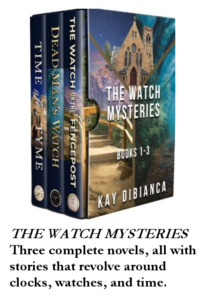
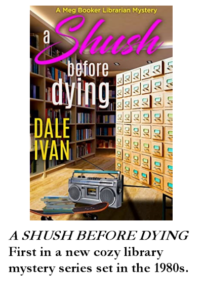
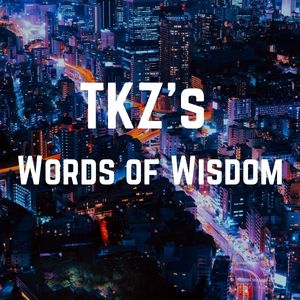

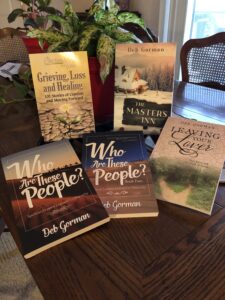


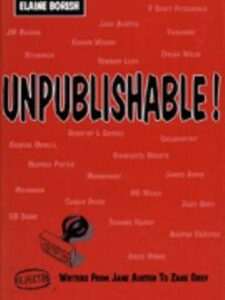
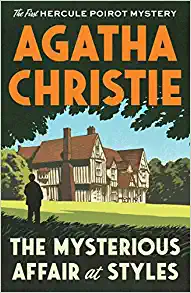

 George Orwell had his masterpiece, “Animal Farm,” turned down by no less than T. S. Eliot, a big deal at UK publishers Faber and Faber. Like many in the upper echelons of publishing, Eliot missed the point when he rejected Orwell: “Your pigs are far more intelligent than the other animals, and therefore the best qualified to run the farm . . . What was needed (someone might argue) was not more communism but more public-spirited pigs.”
George Orwell had his masterpiece, “Animal Farm,” turned down by no less than T. S. Eliot, a big deal at UK publishers Faber and Faber. Like many in the upper echelons of publishing, Eliot missed the point when he rejected Orwell: “Your pigs are far more intelligent than the other animals, and therefore the best qualified to run the farm . . . What was needed (someone might argue) was not more communism but more public-spirited pigs.”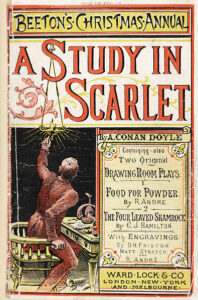 Publishers outdid themselves with boneheaded reasons to reject bestsellers. Conan Doyle’s first Sherlock Holmes novel, “A Study in Scarlet,” was turned down by the prestigious Cornhill magazine because it was too much like the other “shilling shockers” already on the market. The editor said it was too long “and would require an entire issue” – but it was “too short for a single story.” Another publisher sent the manuscript back unread. A third bought the rights for a measly twenty-five pounds, and let it sit around for year. It was published in 1887, and then brought out as a book, but Conan Doyle didn’t get any money from that because he’d sold the rights. Worse, the book was pirated in the U.S. Doyle wrote a couple of historical fiction works. Then an American editor, looking for UK talent, had dinner with Doyle and Oscar Wilde and signed them both up. Wilde wrote “The Picture of Dorian Gray” and Doyle did “The Sign of the Four.”
Publishers outdid themselves with boneheaded reasons to reject bestsellers. Conan Doyle’s first Sherlock Holmes novel, “A Study in Scarlet,” was turned down by the prestigious Cornhill magazine because it was too much like the other “shilling shockers” already on the market. The editor said it was too long “and would require an entire issue” – but it was “too short for a single story.” Another publisher sent the manuscript back unread. A third bought the rights for a measly twenty-five pounds, and let it sit around for year. It was published in 1887, and then brought out as a book, but Conan Doyle didn’t get any money from that because he’d sold the rights. Worse, the book was pirated in the U.S. Doyle wrote a couple of historical fiction works. Then an American editor, looking for UK talent, had dinner with Doyle and Oscar Wilde and signed them both up. Wilde wrote “The Picture of Dorian Gray” and Doyle did “The Sign of the Four.” The other day, I saw a Facebook post from my friend Joseph Finder. I like Joe a lot. We’ve been on panels together. He writes good books that sell really well. He’s a really nice guy. But this photo at left that he posted the other day made me want to…heck, I don’t know what. This is Joe’s writing office. It’s perfect. How would someone NOT get inspired sitting in a place like that? Why can’t I have a writing house like that? Maybe I’ll go up to Cape Cod and TP his…
The other day, I saw a Facebook post from my friend Joseph Finder. I like Joe a lot. We’ve been on panels together. He writes good books that sell really well. He’s a really nice guy. But this photo at left that he posted the other day made me want to…heck, I don’t know what. This is Joe’s writing office. It’s perfect. How would someone NOT get inspired sitting in a place like that? Why can’t I have a writing house like that? Maybe I’ll go up to Cape Cod and TP his…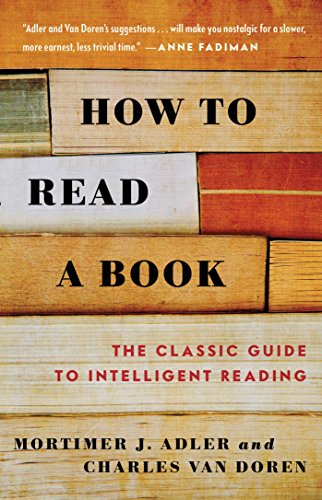
 It’s summer. People are on vacation. Escaping the heat. Or trying to. As a diversion, I thought we might take a few minutes to have a little fun.
It’s summer. People are on vacation. Escaping the heat. Or trying to. As a diversion, I thought we might take a few minutes to have a little fun.

